Cell membrane: responsible for the external relations of the cell
Reactions in the cell condition the proper functioning of the body. At the same time, for the cell to function properly, it is necessary for the cell membrane to function properly, since it is the cell structure in contact with the outside. Its basic function is to delimit each cell. But its contact with the exterior allows it to identify and internalize all substances coming from the outside and, on the contrary, protect them from bad molecules and eliminate them.
Limit formed by lipids
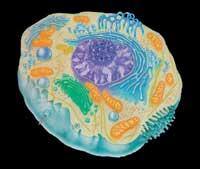
The membrane is the structure of all types of cells. It surrounds the entire cell and has a thickness of 5-8 nanometers. The basic structure of the membrane is the molecule called phospholipid, which are somehow the ‘bricks’ needed to build the membrane.
Phospholipids have a very special molecular structure: they are amphibious. If we look at the three-dimensional structure of the molecule, it presents two very different ends. At one end of the molecule is a group of phosphates. The phosphate group is polar, that is, it has a reaction capacity with water. At the other end are two fatty acid molecules. They do not have any capacity of reaction with water, moreover, they compare water. This end is called non-polar.
Having a polar and a non-polar part in the same molecule, its behavior is very particular. Once phospholipids are placed in an aqueous medium, the polar ends of the molecules tend to interconnect with each other, and the same occurs with non-polar sides. Therefore, thanks to the links that are generated, the molecules form by themselves layers. On one side of the layer are the polar ends and on the other the non-polar ends.
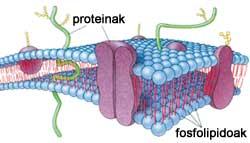
The cell, when forming the membrane, takes advantage of the ordered structure proper to phospholipids. The base of the membrane are two layers of superimposed phospholipids. The polar part of a layer is oriented towards the inside of the cell and the other towards the outside, since both faces are aqueous. The non-polar part of each layer will be placed inside the membrane.
Although phospholipids constitute a stable structure, the relationships between them are not very solid. Phospholipids are able to move through the layer, do not have a fixed and immobile position, so it is possible to give some fluidity to the membrane. This feature is very useful every time a hole appears for any reason, since phospholipids are able to move around the place where they were and fill the hole.
In addition to phospholipids, the most abundant and important molecules in the membrane are proteins. They can be classified according to their position in the membrane: on the outside of the membrane, inside or through the entire membrane. In the latter, one end of the molecule is in contact with the external environment and another end with the inside of the cell. The position of the protein will always depend on its function.
Transport and communication of molecules

In addition to having membranes, organelles and molecules within the cell, it fulfills many other functions. Among them, the most important is to act as a selective barrier. Due to the composition of the membrane, very small molecules, such as those of water, and non-polar, have no problems crossing the membrane. But polar or very large molecules cannot penetrate the cell without help.
The cell, to internalize the necessary polar molecules, has had to create very specialized paths. For each type of molecule there will be a specific input inserted into the membrane. For example, some membrane proteins form channels. Only molecules can be introduced in a determined way through channels or tubes.
In other cases, it has the ability to bond proteins with the necessary molecule, such as the pieces of a puzzle. Subsequently, the protein itself will transport the molecule through the membrane. Evidently, for each type of molecule there will be a specific protein or a special input system of proteins integrated into the membrane.
However, when the food is too large, it is not possible to use modes of transport at the molecular level. Instead, the cell uses the membrane in its entirety. When it comes to internalizing a macromolecule, the macromolecule itself is surrounded by membranes, like a hug. When the ends of the two ‘arms’ of the membrane touch each other, the membrane merges. In this way an intracellular vesicle is created surrounded by membranes with macromolecule inside.
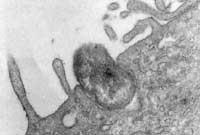
If the macromolecule is to be digested, the digestive enzyme will secrete the cells within this gallbladder. When, thanks to enzymatic work, smaller molecules are obtained that are easily transported, they are removed from the gallbladder and introduced into cell metabolism.
The same happens with the elimination of the waste generated by the cell, but vice versa. The intracellular vesicles fuse with the outer membrane, leaving out what was inside the gallbladder.
In addition to the transport of molecules, another very important function of the membrane is communication. In unicellular organisms it is essential to communicate with other species for reproduction or cooperation. In the pluricellular organisms, communication is obligatory for the growth, development and organization of the whole organism to occur in a coordinated way.
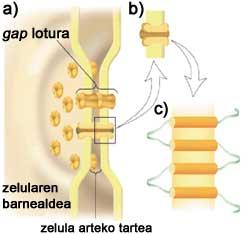
The main pathway of cellular communication is chemistry. The cells are flowing and receiving chemical substances continuously. In multi-cell organisms, chemicals to communicate with distant cells are poured into the blood.
Communication between consecutive cells is much more direct. Contiguous cell membranes are united thanks to special proteins that form the channels. Channels are known as gap links. The channels move the molecules that act as signals, getting the cell's response to be much faster and more direct.
However, when the signal of a distant cell arrives, special proteins located outside the membrane know the signal. Depending on the chemical nature of the signal, the protein that receives the signal acts in one way or another. As with all the molecules, if the signal is polar, it has problems crossing the membrane and it is the protein itself that has to transport inside the cell.

In addition, on many occasions, the signals do not enter the cell. They are attached to a receptor protein located outside the membrane. This protein will be responsible for carrying the signal inside the cell through a chain of chemical reactions. When the signal is a non-polar molecule, it has no problem crossing the membrane or needing a specific transporter.
In general, it can be said that the main function of the membrane is to control what enters and leaves inside the cell. But there are other functions: binding structures between cells, protein systems capable of generating energy... all will appear integrated into the membrane for each type of cell.
The functions that the membrane can perform will depend on the number of proteins present in the membrane. This is clearly seen by comparing a eukaryotic cell with a prokaryote. The first has much less protein in the membrane than prokaryote. The explanation is simple: the prokaryotes have no organelles. Instead, the functions that the organelles will perform will be performed by protein complexes integrated in the membrane. Therefore, the more proteins are in the membrane, the more functions the membrane will perform.

It is clear that the membrane is important for the cell, but physically the structure is very weak. A sudden change in the concentration of water in the external environment of the cell, for example, a significant increase in the concentration of salts, will cause the waters to come out of the cell and the membrane can do nothing to avoid it.
In addition, it has no capacity to give rigidity to the cell, and in many living beings, such as bacteria, it is essential to have a structure that offers rigidity and protection to the cell. Therefore, in most unicellular organisms and in many pluricellular organisms there is another structure above the cell membrane: the cell wall.
Cell wall: protective barrier
Unlike the cell membrane, the cell wall presents a specific composition for each type of cell. It should be noted that the cell wall appears in all prokaryotic organisms (except some bacteria called mycoplasma), plant cells and fungi. Animal cells do not have any cell wall.
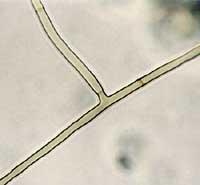
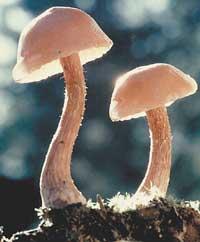
The main component of the plant cell wall is cellulose. All living vegetable cells are included in small boxes of cellulose. This is very easy to see with the microscope: thousands of small boxes are seen. Each of them is a cell embedded in its cellulose box. Thanks to the cases, the cells occupy a very specific position within the plant, which allows the plant to maintain its shape. While the cell inside the case is fully inflated or decreases, the cell wall will maintain the shape of the plant.
In the case of bacteria, although its composition is very different, it fulfills the same functions. It provides rigidity to the cell and reduces the influence of external salt concentrations. In addition, the cell wall is the adhesion point of stretches outside the cell (piles, fungi, etc. ).
And why have animal cells not developed a cell wall? According to various theories, the absence of cell wall has allowed a greater specialization of animal cells. In this way, cells have been created to create movement, nerve cells, and other structures that only appear in animals. Therefore, animal cells have not had to form any wall.





